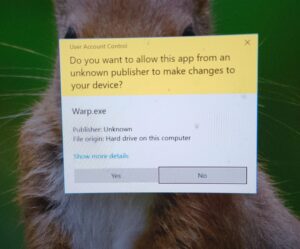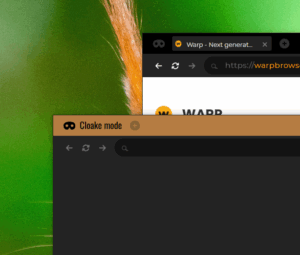Modern browsers provide a private browsing mode (often called Incognito, InPrivate, or similar), which allows users to access the internet without storing certain local data. This mode is designed to minimize traces of the browsing session on the device.
While private modes reduce traces on the local machine, they do not provide anonymity online.
Your:
- IP address is still visible to websites.
- Activity can still be tracked by the network, your ISP, or employer.
- Websites may still fingerprint your device through JavaScript, fonts, screen size, etc.
Also, while local traces are intended to be deleted when the session ends, data may persist in system memory, swap files, or logs, depending on the OS and browser implementation.
How private modes work in standard Browsers?
| Feature \ Browser | Chrome | Firefox | Edge | Warp |
| Mode Name | Incognito | Private Browsing | InPrivate | Cloak Mode |
| Local Data Removal | Deletes cookies and history after session | Same as Chrome | Same as Chrome | Runs entirely in RAM, leaves zero traces |
| Session Isolation | Partial (some metadata may persist) | Partial isolation | Partial isolation | Full containerization per launch, no persistent state |
When User opens a private or incognito window, the Browser creates a separate session context-not a new application, but an isolated runtime environment.
- Session Isolation
The incognito session starts without access to cookies, login data, or local storage from the regular profile. Any new data (e.g., cookies, session storage) is confined to this context and discarded afterward. - Temporary Storage
During the session, necessary assets like images, scripts, or fonts are cached to physical disk in a temporary directory, typically within the browser’s internal profile system. This includes:
- Session cache
- Cookies
- Autofill data used during the session
- Site data (e.g., localStorage, IndexedDB), if allowed
- Cleanup on Exit
Closing all incognito windows triggers deletion of session data. No history or form entries are saved. Downloads remain, but download history is cleared from the browser UI. - Shared System Resources
Despite session separation, incognito tabs often share the same browser engine and system-level processes (memory, networking) as regular tabs. This can expose session metadata at the OS or forensic level.
Security in private browsing – how private is it?
OS and SSD features and settings directly impact how much residual data may persist – even after private browsing sessions.
Here’s how:
- SSD Wear Leveling: Modern SSDs don’t overwrite data directly. Instead, they write new data to different blocks, leaving older versions intact until garbage collection occurs. Deleted session data may physically persist beyond the session’s end.
- Operating System Behavior: File deletion typically removes only the reference, not the actual data. Session content can also leak into swap files or hibernation dumps, especially if RAM is full or the system sleeps.
- Forensic Recovery: Tools can scan these areas to extract residual data such as cache fragments, session cookies, or form inputs – posing risks in high security or regulated environments.
Why Warp Cloak Mode?
Unlike standard private browsing modes, Warp’s Cloak is built to eliminate residue at the system level. It runs entirely in RAM using virtual drives, avoiding hardware disk writes, swap usage, or reliance on OS-level cleanup.
Sessions are isolated, ephemeral, and leave no recoverable trace-by design.
For users and organizations handling sensitive data, this means stronger privacy guarantees, reduced forensic risk, and compliance alignment with stricter security and data protection standards.
Starting a Cloaked session
To start a Cloaking Mode session, click the Cloak icon in the upper-left corner of any Warp window.
If Warp was not launched with administrator privileges, the system will prompt you for permission. This is required to create secure virtual drives at the OS level, which ensure that all session data remains in memory and is never written to disk.
1. Click the Cloak icon in the upper-left corners

2. If prompted by UAC for Admin rights – confirm

3. A new session is indicated by the different color…..

….and also a dedicated, virtual drive IncognitoCash

When the window of the Cloaked session is closed, the associated virtual drive ( and all session data stored in it )is immediately removed from memory. Nothing is written to disk, and no data persists after the session ends.